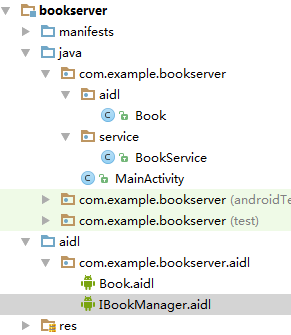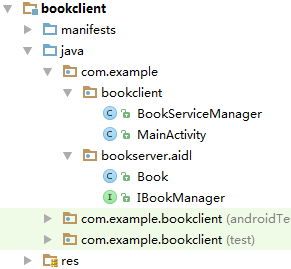Android AIDL实现两个APP间的跨进程通信实例
2018-04-17 11:42
811 查看
本文为大家分享了Android AIDL实现两个APP间的跨进程通信实例,供大家参考,具体内容如下
1 Service端创建
首先需要创建一个Android工程然后创建AIDL文件,创建AIDL文件主要为了生成继承了Binder的Stub类,以便应用Binder进行进程间通信
servier端结构如下

AIDL代码如下
// IBookManager.aidl
package com.example.bookserver.aidl;
// Declare any non-default types here with import statements
import com.example.bookserver.aidl.Book;
interface IBookManager {
/**
* Demonstrates some basic types that you can use as parameters
* and return values in AIDL.
*/
void basicTypes(int anInt, long aLong, boolean aBoolean, float aFloat,
double aDouble, String aString);
List<Book> getBook();
boolean addBook(in Book book);
}
package com.example.bookserver.aidl; parcelable Book;
之后创建一个实现了Parcelable的Book.java类用来传递数据
package com.example.bookserver.aidl;
import android.os.Parcel;
import android.os.Parcelable;
/**
* Created by SAMSUNG on 2016-09-07.
*/
public class Book implements Parcelable {
private int id;
private String name ;
public int getId() {
return id;
}
public void setId(int id) {
this.id = id;
}
public String getName() {
return name;
}
public void setName(String name) {
this.name = name;
}
@Override
public String toString() {
return "Book{" +
"id=" + id +
", name='" + name + '\'' +
'}';
}
@Override
public int describeContents() {
return 0;
}
@Override
public void writeToParcel(Parcel dest, int flags) {
dest.writeInt(this.id);
dest.writeString(this.name);
}
public Book() {
}
protected Book(Parcel in) {
this.id = in.readInt();
this.name = in.readString();
}
public static final Parcelable.Creator<Book> CREATOR = new Parcelable.Creator<Book>() {
@Override
public Book createFromParcel(Parcel source) {
return new Book(source);
}
@Override
public Book[] newArray(int size) {
return new Book[size];
}
};
}
最后我们来写一个Service用于客户端绑定
package com.example.bookserver.service;
import android.app.Service;
import android.content.Intent;
import android.os.Binder;
import android.os.IBinder;
import android.os.RemoteException;
import com.example.bookserver.aidl.Book;
import com.example.bookserver.aidl.IBookManager;
import java.util.List;
import java.util.concurrent.CopyOnWriteArrayList;
public class BookService extends Service {
private CopyOnWriteArrayList<Book> boookList = new CopyOnWriteArrayList<Book>();
public BookService() {
}
Binder binder = new IBookManager.Stub(){
@Override
public void basicTypes(int anInt, long aLong, boolean aBoolean, float aFloat, double aDouble, String aString) throws RemoteException {
}
@Override
public List<Book> getBook() throws RemoteException {
return boookList;
}
@Override
public boolean addBook(Book book) throws RemoteException {
return boookList.add(book);
}
};
@Override
public IBinder onBind(Intent intent) {
return binder;
}
@Override
public void onCreate() {
super.onCreate();
Book book = new Book();
book.setId(12345);
book.setName("Book 1");
boookList.add(book);
}
}
这样Server端就搞定了,接下来就该进行Client端的代码编写了
2 Client端
Client端结构如下

首先我们要讲AndroidStudio 通过AIDL生成的Binder导入到Client中并将Book.java也导入到Client中
然后写进行Service的绑定
package com.example.bookclient;
import android.app.Service;
import android.content.ComponentName;
import android.content.Context;
import android.content.Intent;
import android.content.ServiceConnection;
import android.content.pm.PackageManager;
import android.content.pm.ResolveInfo;
import android.os.IBinder;
import android.util.Log;
import com.example.bookserver.aidl.IBookManager;
import java.util.List;
/**
* Created by SAMSUNG on 2016-09-07.
*/
public class BookServiceManager {
Context mContext = null;
IBookManager mService = null;
private static BookServiceManager bsm ;
public static BookServiceManager getInstance(Context context){
if(bsm==null){
bsm = new BookServiceManager(context);
}
return bsm;
}
public IBookManager getBookServie(){
while (mService==null){
Log.d("BookServiceManager", "getBookServie: ");
this.connectService();
}
return mService;
}
public BookServiceManager(Context mContext) {
this.mContext = mContext;
}
ServiceConnection scc = new ServiceConnection() {
@Override
public void onServiceConnected(ComponentName name, IBinder service) {
Log.d("BookServiceManager", "getBookServie: 2 ==> Bind ");
mService = IBookManager.Stub.asInterface(service);
}
@Override
public void onServiceDisconnected(ComponentName name) {
mService = null;
}
};
public boolean connectService(){
if(mService == null){
Log.d("BookServiceManager", "getBookServie: 2");
Intent intent = new Intent("com.example.bookserver.service.BookService");
final Intent eintent = new Intent(createExplicitFromImplicitIntent(mContext,intent));
mContext.bindService(eintent,scc, Service.BIND_AUTO_CREATE);
}
return true;
}
public static Intent createExplicitFromImplicitIntent(Context context, Intent implicitIntent) {
// Retrieve all services that can match the given intent
PackageManager pm = context.getPackageManager();
List<ResolveInfo> resolveInfo = pm.queryIntentServices(implicitIntent, 0);
// Make sure only one match was found
if (resolveInfo == null || resolveInfo.size() != 1) {
return null;
}
// Get component info and create ComponentName
ResolveInfo serviceInfo = resolveInfo.get(0);
String packageName = serviceInfo.serviceInfo.packageName;
String className = serviceInfo.serviceInfo.name;
ComponentName component = new ComponentName(packageName, className);
// Create a new intent. Use the old one for extras and such reuse
Intent explicitIntent = new Intent(implicitIntent);
// Set the component to be explicit
explicitIntent.setComponent(component);
return explicitIntent;
}
}
最后对设置Button进行调用
package com.example.bookclient;
import android.os.Bundle;
import android.os.RemoteException;
import android.support.v7.app.AppCompatActivity;
import android.util.Log;
import android.view.View;
import android.widget.Button;
import com.example.bookserver.aidl.Book;
import com.example.bookserver.aidl.IBookManager;
public class MainActivity extends AppCompatActivity {
IBookManager mBookService ;
@Override
protected void onCreate(Bundle savedInstanceState) {
super.onCreate(savedInstanceState);
setContentView(R.layout.activity_main);
Button button = (Button) findViewById(R.id.button);
Button addButton = (Button) findViewById(R.id.button3);
Button findButton = (Button) findViewById(R.id.button2);
BookServiceManager.getInstance(getApplication()).connectService();
button.setOnClickListener(new View.OnClickListener(){
@Override
public void onClick(View v) {
mBookService = BookServiceManager.getInstance(getApplication()).getBookServie();
}
});
addButton.setOnClickListener(new View.OnClickListener(){
@Override
public void onClick(View v) {
Book book = new Book();
book.setId(2345);
book.setName("add book!!");
try {
mBookService.addBook(book);
} catch (RemoteException e) {
e.printStackTrace();
}
}
});
findButton.setOnClickListener(new View.OnClickListener(){
@Override
public void onClick(View v) {
try {
Log.d("MainActivity", mBookService.getBook().toString());
} catch (RemoteException e) {
e.printStackTrace();
}
}
});
}
}
这样我们就实现了AIDL的不同APP的调用。
以上就是本文的全部内容,希望对大家的学习有所帮助,也希望大家多多支持脚本之家。
您可能感兴趣的文章:
相关文章推荐
- Android AIDL 实现两个APP之间的跨进程通信实例
- Android使用AIDL实现两个App间通信
- Android例子—AIDL实现两个进程间的简单通信
- Android 使用AIDL实现了两个app之间的通信
- Android基础--使用AIDL实现进程间的通信
- android AIDL实现进程间的通信
- Android基础--使用AIDL实现进程间的通信之复杂类型传递
- (4.1.18.6)Android应用中通过AIDL机制实现进程间的通讯实例
- Android应用中通过AIDL机制实现进程间的通讯实例
- Android开发之通过AIDL服务实现进程间的通信
- Android应用中通过AIDL机制实现进程间的通讯实例
- Android应用中通过AIDL机制实现进程间的通讯实例
- Android通过AIDL实现下载进程通信
- Android-->IPC(跨进程)通信Aidl的实现方法
- 实例讲解Android中的AIDL内部进程通信接口使用
- Android进程通信:AIDL入门实例
- AIDL Android跨进程通信调用实例
- Android开发之使用AIDL和远程服务实现进程通信
- Android应用中通过AIDL机制实现进程间的通讯实例
- Android IPC机制(三)——利用AIDL实现跨进程通信
